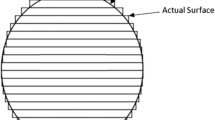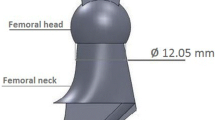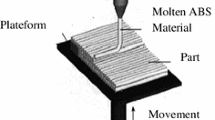Abstract
Fused deposition modelling (FDM) is one of the additive manufacturing processes, which is used to produce three-dimensional functional and non-functional prototypes. This process is commercially acceptable for producing parts with different materials (thermoplastic, wax, etc.), which can be formed into desired shape and can be used as consumable pattern in investment casting (IC) process. The IC process has been established for production of difficult to made parts with high accuracy and finish. By combining both these novel processes, the researchers are serving the field of medicine to satisfy the needs of society. The vapour smoothing is one of the recently developed surface finishing techniques, which has potential to draw remarkable results to improve the quality of FDM replicas and support the IC process to enhance the properties of casted parts. So, in this paper an attempt has been made to develop a biomedical implant by combining these three processes. Also the effects of controlling parameters of combined processes on the hardness and microstructure of the casted implants have been investigated.

















Similar content being viewed by others
References
Syam WP et al (2011) Rapid prototyping and rapid manufacturing in medicine and dentistry. Virtual Phys Prototyp 6(2):79–109
Ferreira JC et al (2004) Rapid manufacturing of medical prostheses. Int J Manuf Technol Manag 6(6):567–583
Pandey PM et al (2001) Improvement of surface finish by staircase machining in fused deposition modelling. J Mater Process Technol 132:323–331
Upcraft S et al (2003) The rapid prototyping technologies. Assem Autom 23:318–330
Kumar P et al (2012) Application of fusion deposition modelling for rapid investment casting—a review. Int J Mater Eng Innov 3:204–227
Kumar P et al (2015) Investigations for mechanical properties of hybrid investment casting: a case study. Mater Sci Forum 808:89–95
Kumar P et al (2013) Framework for developing a hybrid investment casting process. Asian Rev Mech Eng 2:49–55
Pham DT et al (1998) A comparison of rapid prototyping technologies. Int J Mach Tools Manuf 38:1257–1287
Lam TW et al (1998) Reinforced thin shell objects rapid prototyping by fused deposition modeling. Int J Adv Manuf Technol 14:631–638
Tukuru N et al (2008) Rapid prototype technique in medical field. Res J Pharm Technol 1:341–344
Chabbra M et al (2011) Rapid casting solutions: a review. Rapid Prototyp J 17:328–350
Rosochwski A et al (2000) Rapid tooling: the state of the art. J Mater Process Technol 106:191–198
Berce P et al (2005) The application of rapid prototyping technologies for manufacturing the custom implants. In: ESAFORM 2005 conference on rapid prototyping and rapid tooling. Cluj-Napoca, Romani, pp 679–682
Gibson I et al (2006) The use of rapid prototyping to assist medical applications. Rapid Prototyp J 12(1):53–58
Chua CK et al (1998) A study of state of the art rapid prototyping technologies. Int J Adv Manuf Technol 14:146–152
Singh R et al (2014) Development of biomedical implant (hip joint) by combining fused deposition modelling and investment casting. In: Proceedings of the international conference on research and innovations in mechanical engineering. Lecture notes in mechanical engineering. Springer, New York, pp 225–232
Roath M (2012) Analysis of the microstructure and hardness of a direct digital manufactured metal used for an acetabular cup implant. In: Proceedings of the national conference of undergraduate research
Ahn D et al (2009) Representation of surface roughness in fused deposition modeling. J Mater ProcessTechnol 209:5593–5600
Rahmati S et al (2007) Dimensional accuracy analysis of wax patterns created by RTV silicon rubber molding using Taguchi approach. Rapid Prototyp J 13:115–122
Galantucci LM et al (2012) Direct digital manufacturing of ABS parts: an experimental study on effectiveness of proprietary software for shrinkage compensation. Int J Digital Content Technol Appl 6:546–555
Macku M et al (2012) Applying RP-FDM technology to produce prototype castings using the investment casting method. Arch Foundry Eng 12:75–82
Idris MH et al (2008) Evaluation of ABS patterns produced from FDM for investment casting process. In: Proceedings of the ninth Asia Pacific industrial engineering and management systems conference, pp 1299–1304
Gregorian A et al (2001) Accuracy improvement in rapid prototyping machine (FDM-1650). In: Solid freeform fabrication proceedings, 12th, solid freeform fabrication symposium, pp 77–84
Bidanda B et al (1991) Reverse engineering and rapid prototyping. In: Dorf RC, Kusiak A (eds) Handbook of design, manufacture and automation. Wiley, New York, pp 977–991
Pandey PM et al (2003) Improvement of surface finish by staircase machining in fused deposition modelling. J Mater Process Technol 1:323–331
Kumar P et al (2016) Experimental investigations on hardness of the biomedical implants prepared by hybrid investment casting. J Manuf Process 21:160–171
Yamada T et al (2006) Mechanical property and microstructural change by thermal aging of SCS14A cast duplex stainless steel. J Nucl Mater 350:47–55
Ganesh P et al (2009) Laser rapid manufacturing of bi-metallic tube with Stellite-21 and austenitic stainless steel. Trans Indian Inst Met 62:169–174
Asgari M et al (2011) Microstructural characterization of pulsed plasma nitrided 316L stainless steel. Mater Sci Eng A 529:425–434
Chandra K et al (2012) Low temperature thermal ageing embrittlement of austenitic stainless steel welds and its electrochemical assessment. Corros Sci 54:278–290
Martins M et al (2009) Microstructural characteristics and corrosion behavior of a super duplex stainless steel casting. Mater Charact 60:150–155
Mehr FF et al (2014) Effect of chill cooling conditions on cooling rate, microstructure and casting/chill interfacial heat transfer coefficient for sand cast A319 alloy. Int J Cast Met Res 27:288–300
Chohan JS et al (2016) Enhancing dimensional accuracy of FDM based biomedical implant replicas by statistically controlled vapor smoothing process. Prog Addit Manuf 1(1):105–113
Priedeman Jr WR et al (2012) Smoothing method for layered deposition modeling. United States patent US 8,123,999B2
Espalin D et al (2009) Effects of vapor smoothing on ABS part dimensions. In: Rapid 2009 conference and exposition. Society of Manufacturing Engineers, Schaumburg, IL, USA, May 12–14
Sood AK et al (2009) Improving dimensional accuracy of fused deposition modelling processed part using grey Taguchi method. J Mater Des 30:4243–4252
MINITAB 17 Statistical software package, User Manual. Copyright © 2013 Minitab Inc
Yadav N et al (2011) Effect of process parameters on mechanical properties of the investment castings produced by using expandable polystyrene pattern. Int J Adv Eng Technol 1:128
Krishnaiah K et al (2012) Applied design of experiments and Taguchi methods, 4th edn. PHI Learning Pvt Ltd, New Delhi, p 248
Acknowledgements
The authors are thankful to IKGPTU Jalandhar, Department of Production Engineering, GNDEC, Ludhiana, DST (GoI), for financial support.
Author information
Authors and Affiliations
Corresponding author
Additional information
Technical Editor: João Marciano Laredo dos Reis.
Publisher's Note
Springer Nature remains neutral with regard to jurisdictional claims in published maps and institutional affiliations.
Rights and permissions
About this article
Cite this article
Singh, D., Singh, R. & Boparai, K.S. Investigations on hardness of investment-casted implants fabricated after vapour smoothing of FDM replicas. J Braz. Soc. Mech. Sci. Eng. 42, 178 (2020). https://doi.org/10.1007/s40430-020-2265-y
Received:
Accepted:
Published:
DOI: https://doi.org/10.1007/s40430-020-2265-y




